2Department of Thoracic Surgery, Health of Science University Sureyyapasa Chest Diseases and Thoracic Surgery Teaching and Research Hospital, İstanbul, Turkey DOI : 10.26663/cts.2020.00023
Summary
Background: Increasing neutrophil to lymphocyte ratio (NLR) and platelet to lymphocyte ratio (PLR) define and grade systemic inflammation in lung cancer patients. We hypothesized a decrease in NLR and PLR after tumor resection, and their potential prognostic value in follow-up.Materials and Methods: Adult patients diagnosed previously (and/or histopathologically after lung surgery) with NSCLC were enrolled from the1st January 2016 to 1st January 2018. Patients were grouped according to tumor size (≥ 5 cm and < 5 cm) and sub-grouped by gender and type of surgery (lobectomy and pneumonectomy). Patient information was recorded from the hospital database and included age, gender, hemogram and blood biochemistry values, results, and before and after lung resection. Total leukocyte count, neutrophil count, NLR, PLR, PLT/MPV, and C-reactive protein (CRP) were recorded and calculated. Mortality was recorded during the follow-up period.
Results: Among the 314 included patients (56, 18% female, mean age 60 years, SD=11) pneumonectomy and lobectomy numbers were 56 (18%) and 258 (82%), respectively, and 92 (29%) patients had larger tumors and 222 (71%) had smaller tumors NLR, PLR and CRP median values immediately before and after tumor resection were 17.08 vs. 10.03, P < 0.001, 315.61 vs. 215.10, P < 0.001, and 9.0 vs. 9.5, P = 0.10, respectively. Median follow-up was 300 days (IQR 198-381), and 36 (11.5%) patients died. Cox regression showed that a post-operative NLR ≥ 12.0 was a significant prognostic indicator (HR: 2.09, CI 95% [1.08-4.06], and P = 0.029).
Conclusions: NLR >12 after lung resection may be an important prognostic value for six-month mortality. NLR and PLR may be useful biomarkers in NSCLC immediately post-surgery and for long-term follow-up.
Introduction
Lung cancer is the second highest cause of worldwide deaths, inclusive of both high and low-income countries, and non–small cell cancer (NSCLC) is observed in approximately 85% of lung cancers [1]. Surgery is the standard treatment of stage 1 and stage 3A lung cancers [2]. Tumor cell spreading is established by angiogenesis and cancer cell proliferation [3,4] and the T and B lymphocytes and neutrophils are indicated to have a role in tumor inflammation (spreading). An increasing neutrophil to lymphocyte ratio (NLR) is reported to define, as well indicate the degree, of systemic inflammation in patients with tumors [5,6].Recent studies have shown promising results in defining novel inflammatory biomarkers in lung cancer that may indicate the progression of disease or response to therapy. These studies show that an increased pre-operative or pre-treatment NLR and platelet to lymphocyte ratio (PLR) (calculated from peripheral blood tests) have been found to be independent and easy, low cost prognostic biomarkers in patients with lung cancer, including small cell and non-small cell lung cancer [7-10]. There have been limited studies in patients with NSCLC who have undergone a lung resection and where NLR and PLR are evaluated as survival predictor biomarkers [11,12]. NLR and PLR indices are not well studied in terms of acute changes immediately after lung resection with different size tumors in patients with NSCLC.
In the present study, we hypothesized that NLR is an index of systemic inflammation in patients with NSCLC where the larger tumors (≥ 5 cm) may result in higher NLR and PLR ratios, and these biomarkers may decrease immediately after tumor resection. We also aimed to determine six-month survival rates after lung resection and to assess whether a decrease in NLR and PLR were indicative of a more promising survival rate.
Methods
This study was a retrospective, cohort designed study conducted in Health of Science University Sureyyapasa Chest Diseases and Thoracic Surgery Teaching and Research Hospital. The study was approved by the local ethical committee of the hospital (14.05.2018/036) and was conducted in accordance with the principles of the Declaration of Helsinki. All study data were collected retrospectively from the hospital electronic database. Due to the retrospective nature of the study, informed consent was not obtained from the patients for the use of medical data for publication purpose, and this was waived by the institution’s local scientific committee, in line with the local legislation. All patients’ ID information was strictly protected. This study has been reported in line with the STROCSS criteria [13].
Patients
Adult patients (aged 18 and above) were enrolled in the study, if diagnosed with NSCLC previously and/or histopathologically after lung surgery in the study period (1st January 2016 to 1st January 2018). Adenocarcinoma, epidermoid carcinoma and lung cancer other than small cell lung cancer were also defined. Patient enrollment, inclusion criteria and exclusion criteria are summarized in Figure 1. Patients were grouped according to tumor size, i.e., larger tumor (≥5 cm) and smaller tumor (<5 cm) and sub-grouped by gender and type of surgery (lobectomy and pneumonectomy).
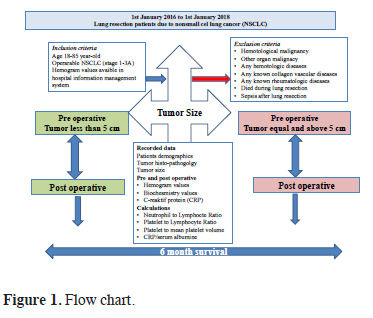 Click Here to Zoom |
Figure 1: Flow chart. |
Definitions and Calculations
Neutrophil lymphocyte ratio (NLR): As a marker of systemic inflammation NLR was defined as absolute neutrophil count divided by absolute lymphocyte count. Elevated NLR values were accepted as five or above, as defined previously [15]. NLR was further grouped as dichotomous at five and according to cutoff values for long-term mortality.
Platelet to lymphocyte ratio (PLR): PLR was defined as the absolute platelet count divided by absolute lymphocyte count. A PLR of 300 was defined as elevated, and was grouped as dichotomous above and below 300 [15].
Platelets/MPV ratio: As a marker of systemic inflammation the ratio of platelet count to mean platelet volume was calculated.
C- reactive protein/serum albumin ratio (CAR): Defined as the ratio of CRP to serum albumin as a prognostic value of pretreatment in solid tumors [16].
Delta values of NLR; PLR; PLT/PMV; CAR; CRP: Defined as pre-operative values minus post-operative values.
Recorded Data
Patient information recorded from the hospital database included age, gender, hemogram and blood biochemistry values, and laboratory results on admission to the hospital, before and after lung resection. The type of histopathology’s reported by the pathology specialists were adeno cancer, epidermoid cancer, large cell cancer and others. As inflammatory markers, total leukocyte count, neutrophil count, NLR, PLR, PLT/MPV, C-reactive protein (CRP), and CRP/serum albumin were recorded and calculated.
Whole blood cell counts including total leukocyte, neutrophil, eosinophil, lymphocyte, platelet counts, and MPV were determined using a Coulter LH 780 Hematology Analyzer (Beckman Coulter, USA). CRP was determined using the nephelometry method BN II System (Siemens, Germany). The normal range of CRP is 0-5 mg/L.
Statistical Analysis
Statistical analyses were done using the portable SPSS-20 version package program. Patient demographics and all clinical data were summarized by descriptive analysis. The Student’s t-test was used for continuous variables, e.g., age, hemogram values, biochemistry values, NLR, PLR, PLT/MPV, and CRP, if distributed normally between the two groups. The values from the Student’s t-test were shown as the median ± standard deviation (SD). If the groups were distributed non-normally, the non-parametric Mann-Whitney U test was used, and the values were shown as the median and inter quartile range (IQR, 25% and 75%). Dichotomous values (i.e. gender, types of tumor pathology, and tumor size) were compared using the Chi-Square test. For non-parametric values, the Wilcoxon Signed Rank test was used to compare pre- and post-operative hemogram and biochemistry values and biomarkers. The Spearman’s rho, non-parametric correlations test was used for group correlations with inflammatory biomarkers. To define the long-term mortality cut-off values of NLR, PLR, PLT/MPV, and CPR, the receiver operating characteristic (ROC) curve was used, and the area under the curve (AUC) was obtained to determine the optimal cut-off values. Kaplan Meier survival analysis was used for long-term survival for researched inflammatory biomarkers. The Cox Regression hazard analysis was performed for patients who underwent lung resection due to non-small cell lung cancer. NLR values pre-and post-surgery greater than 5and 12, respectively, and PLR values above 300 were included in the model [12]. A p-value less than 0.05 was accepted as statistically significant.
Results
In the study period 314 eligible (56[18%] female) patients were enrolled. The mean age was 60 years (SD 11 years). The median tumor size was 3.5 cm (IQR 2.5-5.0 cm). The pneumonectomy and lobectomy numbers were 56 (18%) and 258 (82%), respectively. Patients were grouped according to tumor size as ≥ 5 cm (n = 92, 29%) and < 5 cm (n = 222, 71%). The types of NSCLC were as follows; 105 (33%) had adeno cancer, 158 (50%) had epidermoid cancer, 4 (1.3%) had large cell cancer, and 47 (15%) had other types.Table 1 summarizes the pre- and post-operative hemogram and biochemistry values of the 314 patients with NSCLC. Clinically important and statistically significant changes were observed in blood glucose and serum albumin levels.
Table 1: Patient hemogram and biochemistry values pre and post non-small cell lung cancer surgery.
Table 2 shows a comparison of biomarkers between patient’s grouped according to tumor size (≥ or < 5 cm). The group with the larger tumor size (≥ 5 cm) were older and all the biomarkers assessed had significantly unfavorable values, except for WBC and NLR. There were no significant differences in biomarkers before and after surgery in both tumor size groups.
The biomarkers were similar for both males and females pre- and post-lung resection except for post-operative NLR, which was significantly greater in males compared with females (Table 3).
Table 4 shows pre-operative and post-operative biomarkers in all patients’ subgrouped according to the type of lung resection and tumor histopathology. Apart from CRP, all the biomarkers assessed showed statistically significant changes.
Table 4: Inflammatory biomarkers pre- and post-lung resection in patients with lung cancer.
Figures 2a and b show changes in the NLR, PLT/MPV, CRP and PLR median values from the pre- to post-operative period. After tumor resection NLR, PLR were favorably decreased, while CRP was unchanged. The PLT/MPV changes were not clinically relevant.
 Click Here to Zoom |
Figure 2a: NLR, PLT/MPV and CRP median values from the pre- to post-operative period. After tumor resection NLR were favorably decreased, while CRP was unchanged. The PLT/MPV changes were not clinically relevant. |
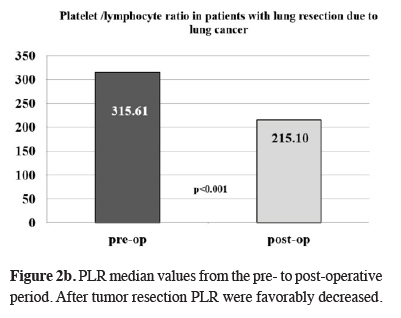 Click Here to Zoom |
Figure 2b: PLR median values from the pre- to post-operative period. After tumor resection PLR were favorably decreased. |
Table 5 summarizes the comparison of biomarkers of patients who underwent pneumonectomy and lobectomy. Pre-postoperative PLR were significantly unfavorably higher in patients with pneumonectomy. All other biomarkers were similar for both types of surgery.
Table 6 shows a correlation of the studied biomarkers with tumor size and each other. Pre-operative PLR and PLT/MPV showed significance correlation with tumor size. Delta changes (defined as the pre-operative value minus the post-operative value), showed that delta NLR correlated well with delta PLR and delta WBC but not delta CRP. Delta PLR correlated weakly with delta WBC, and delta PLT/MPV, but not delta CRP.
Figure 3 shows the cutoff values for mortality in the pre-operative period for NLR were 20.55 (sensitivity 61%, specificity 62%), and 12 in the post-operative period (sensitivity 58%, specificity 62%). In Figure 3 of the Area Under the Curve for biomarkers in 36 non-survivors with NSCLC were summarized in Table 7.
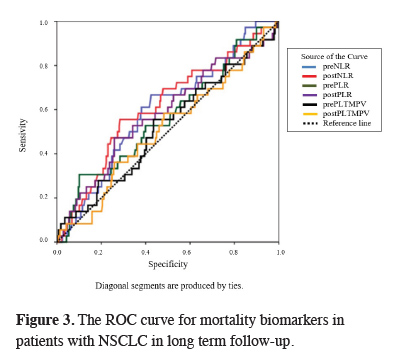 Click Here to Zoom |
Figure 3: The ROC curve for mortality biomarkers in patients with NSCLC in long term follow-up. |
Table 7: Area Under the Curve for biomarkers in 36 non-survivors with NSCLC.
Figures 4a and b show the long-term survival of patients with NSCLC after surgery in a Kaplan Meier analysis of a post-operative NLR of 12.0 and tumor size 5 cm and greater.
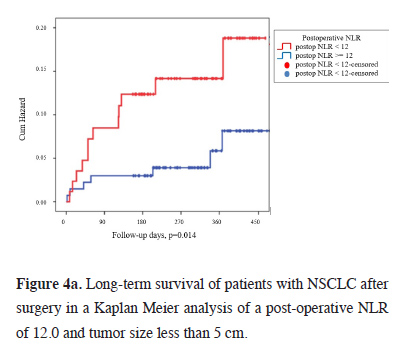 Click Here to Zoom |
Figure 4a: Long-term survival of patients with NSCLC after surgery in a Kaplan Meier analysis of a post-operative NLR of 12.0 and tumor size less than 5 cm. |
 Click Here to Zoom |
Figure 4b: Long-term survival of patients with NSCLC after surgery in a Kaplan Meier analysis of a post-operative NLR of 12.0 and tumor size 5 cm and above. |
Figure 5 shows the Cox regression hazard ratio analysis of 36 non-survivors during the follow-up period. Pre- and post-surgery values of NLR > 5 and > 12, respectively and PLR values above 300 were included in the model. A post-operative NLR of 12.0 and above showed a significant hazard ratio (HR: 2.09, CI 95% [1.08-4.06] and P = 0.029).
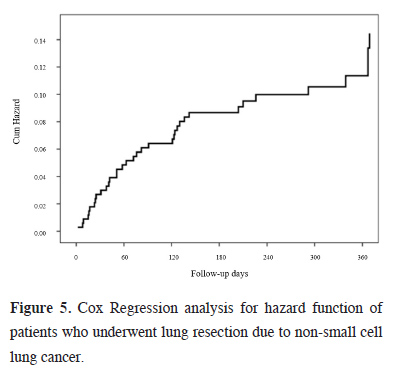 Click Here to Zoom |
Figure 5: Cox Regression analysis for hazard function of patients who underwent lung resection due to non-small cell lung cancer. |
Discussion
This study showed that indices of systemic inflammation in patients with NSCLC, namely NLR and PLR, were significantly decreased immediately after tumor resection. After removal of the tumor tissue, whether the tumor was small (< 5cm) or larger (≥ 5cm), the decrease in blood biomarker levels, including NLR, PLR, were similar. We also determined the NLR cutoff value immediately following tumor resection to be 12 for a two-fold increase in long-term mortality risk.Hanahan et al showed the prognostic importance of a pro-inflammatory tumor microenvironment [17], and further studies defined the evidence of interaction between inflammatory cells and the growing tumor tissue [18] and showed that increased PLR, NLR, CRP values had prognostic significant correlated to cancer spread [19]. In the present study, we showed that NLR, PLR, and PLT/MPV values, but not CRP, were decreased the day after removal of the NSCLC tumor. These findings support the theory that these inflammatory biomarkers are elevated by the growing tumor tissue. The change in the studied biomarkers pre- and post-surgery were similar whether the tumors were > or < 5 cm. However, apart from NLR, all the other biomarkers (PLR, PLT/PMV, CAR, and CRP) had a significantly higher level in those cases with tumors ≥ 5 cm compared with those with tumors < 5 cm. Although changes in both PLR and NLR were well correlated, there was no meaningful correlation with tumor size and NLR; the only statistically significant correlation found relative to tumor size was in the case of pre-operative PLR and PLT/MPV. Pre-operative biomarker values were similar in females and males, however, after surgery, females showed a more significant decrease in NLR. A recent meta-analysis suggested that an elevated CAR was indicative, not only of sepsis, but also of unfavorable clinico-pathological findings in solid tumors [16]. In the present study, although unchanged after surgery, CAR values were nearly three times higher in the bigger tumor size group. CAR values may not be as quickly changed due to serum albumin being a chronic clinical state biomarker and may need time to normalize.
A recent meta-analysis evaluated pretreatment (either chemotherapy or surgery) NLR in patients with NSCLC. This meta-analysis showed that elevated NLR was associated with a poor prognosis in terms of overall survival and progress-free survival [9]. It also showed that elevated NLR indicated a worse prognosis in NSCLC patients’ treated with chemotherapy compared with surgery. The authors advised further study to clarify the effect with surgery [9]. The results presented in the current study indicate the potential prognostic usefulness of NLR values in patients with NSCLC. We revealed that after lung resection, patients with NLR values over 12 had a two-fold mortality rate in the six-month follow-up period. In the previously cited meta-analysis NLR values were between 2.5 to 5 [9]. Tomita and coworkers studied a similar patient population that included 284 NSCLC patients who received a lung resection, either lobectomy or pneumonectomy and were followed for a five-year period. They defined five-year survival factors and showed that NLR values greater than 2.5 increased the mortality risk [14]. Pinato et al looked at NLR and PLR biomarkers in 220 patients with NSCLC who underwent lung resection and they revealed that an NLR value of five had an unfavorable prognostic significance. In the present study, the Cox regression model showed that a NLR value of five was not correlated with six-month mortality in patients with NSCLC. Sarraf et al assessed the correlation of NLR values with prognosis in 177 patients with NSCLC who underwent lung resection [11]. In their study, the median (IQR) NLR values of all patients was 3.13 (2.08–4.36) and the hazard ratio of each increased NLR for long term survival was 1.10. In the present study the median NLR value was nearly five times greater than Sarraf’s study.
The strength of this study was that all the data were obtained from an electronic hospital database thus preventing data entry errors. The limitations were firstly that this was a retrospective, single center study. However, the study center is a specialized in chest and thoracic surgery and is the biggest center of its kind in the country, indicating that the results may be meaningful for clinicians. The second limitation is that the follow-up period of six months was not long enough and the number of deaths during the follow-up period was relatively small (n = 36) potentially resulting in an underestimation of prognostic predictors. Nonetheless, the primary concern of the study was to determine acute changes in biomarkers post-surgery, and their value as prognostic predictors.
In conclusion, immediately after tumor resection, NLR, PLR, and even PLT/MPV were decreased, supporting the direct relationship of these biomarkers with the tumor. Tumor size tended to increase the level of studied biomarkers to some extent. The decrease in biomarker values post-resection was independent of the size of the tumor. A NLR > 12 post-lung resection may be an important prognostic value for long-term (six-month) mortality. NLR and PLR may be helpful biomarkers for NSCLC, both after surgery and during long-term follow-up.
Acknowledgements
The authors thank Zuhal Karakurt for providing support for this study and Sharon Forsyth for editing the manuscript.
Declaration of conflicting interests
The authors declared no conflicts of interest with respect to the authorship and/or publication of this article.
Funding
The authors received no financial support for the research and/or authorship of this article.
Reference
1) Al-Othman S, Haoudi A, Alhomoud S, Alkhenizan A, Khoja T, Al-Zahrani A. Tackling cancer control in the Gulf Cooperation Council Countries. Lancet Oncol 2015 16: e246-57.
2) Kris MG, Gaspar LE, Chaft JE, Kennedy EB, Azzoli CG, Ellis PM et al. Adjuvant Systemic Therapy and Adjuvant Radiation Therapy for Stage I to IIIA Completely Resected Non-Small-Cell Lung Cancers: American Society of Clinical Oncology/Cancer Care Ontario Clinical Practice Guideline Update. J Clin Oncol 2017:35;2960-74.
3) Mantovani A, Allavena P, Sica A, Balkwill F. Cancer-related inflammation. Nature 2008; 454: 436-44.
4) Hanahan D, Weinberg RA. Hallmarks of cancer: the next generation. Cell 2011;144:646-74.
5) Schreiber RD, Old LJ, Smyth MJ. Cancer immunoediting: integrating immunity’s roles in cancer suppression and promotion. Science 2011;331:1565-70.
6) Roxburgh CS, McMillan DC. Role of systemic inflammatory response in predicting survival in patients with primary operable cancer. Future Oncol 2010;6:149-63.
7) Yin Y, Wang J, Wang X, Gu L, Pei H, Kuai S et al. Prognostic value of the neutrophil to lymphocyte ratio in lung cancer: A meta-analysis. Clinics (Sao Paulo) 2015;70:524-30.
8) Liu D, Huang Y, Li L, Song J, Zhang L, Li W. High neutrophil-to-lymphocyte ratios confer poor prognoses in patients with small cell lung cancer. BMC Cancer 2017;17:882.
9) Peng B, Wang YH, Liu YM, Ma LX. Prognostic significance of the neutrophil to lymphocyte ratio in patients with non-small cell lung cancer: a systemic review and meta-analysis. Int J Clin Exp Med 2015;8:3098-106.
10) Unal D, Eroglu C, Kurtul N, Oguz A, Tasdemir A. Are neutrophil/lymphocyte and platelet/lymphocyte rates in patients with non-small cell lung cancer associated with treatment response and prognosis? Asian Pac J Cancer Prev 2013;14:5237-42.
11) Sarraf KM, Belcher E, Raevsky E, Nicholson AG, Goldstraw P, Lim E. Neutrophil/lymphocyte ratio and its association with survival after complete resection in non-small cell lung cancer. J Thorac Cardiovasc Surg 2009;137:425-8.
12) Pinato DJ, Shiner RJ, Seckl MJ, Stebbing J, Sharma R, Mauri FA. Prognostic performance of inflammation-based prognostic indices in primary operable non-small cell lung cancer. Br J Cancer 2014;110:1930-5.
13) Agha RA, Borrelli MR, Vella-Baldacchino M, Thavayogan R, Orgill DP, for the STROCSS Group. The STROCSS Statement: Strengthening the Reporting of Cohort Studies in Surgery. Int J Surg 2017;46:198-202.
14) Tomita M, Shimizu T, Ayabe T, Yonei A, Onitsuka T. Preoperative neutrophil to lympho¬cyte ratio as a prognostic predictor after cura¬tive resection for non-small cell lung cancer. Anticancer Res 2011;31:2995-8.
15) Pinato DJ, Mauri FA, Ramakrishnan R, Wahab L, Lloyd T, Sharma R. Inflammation-based prognostic indices in malignant pleural mesothelioma. J Thorac Oncol 2012;7:587-94.
16) Wu J, Tan W, Chen L, Huang Z, Mai S. Clinicopathologic and prognostic significance of C-reactive protein/albumin ratio in patients with solid tumors: an updated systemic review and meta-analysis. Oncotarget 2018;9:13934-47.
17) Hanahan D, Weinberg RA Hallmarks of cancer: the next generation. Cell 2011;144:646-74.






